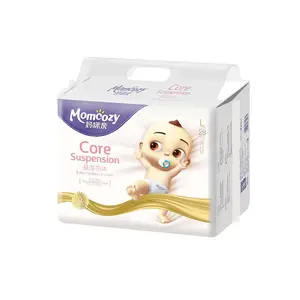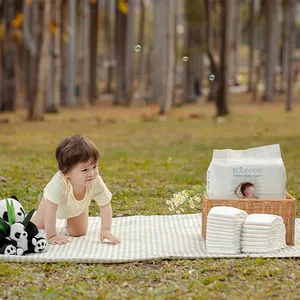
All categories
Featured selections
Trade Assurance
Buyer Central
Help Center
Get the app
Become a supplier

(29389 products available)







































Diapers are essential for every baby. They help keep them clean and dry. Many parents rely on baby diapers manufacturers to provide quality diapers for their babies. There are two main types of diapers:
Manufacturers make diapers from soft and comfortable materials for babies. They also have super absorbent cores. These cores absorb and lock wetness away from the baby's skin. This feature keeps the baby dry and helps prevent diaper rash. Most diapers have elastic leg bands and waistlines. These design features give babies a snug and comfortable fit. They also prevent leaks.
Another important thing about diapers is the wetness indicator. It is a line that changes color when the diaper is wet. The wetness indicator helps parents know when to change the diaper without opening it. This feature is especially useful for first-time parents.
Diapers come in different sizes to suit babies of all ages. Manufacturers label the sizes according to the baby's weight. There are newborn sizes for babies at birth, infant sizes for younger babies, and toddler sizes for older babies who are nearing potty training.
Manufacturers package diapers in large quantities for wholesalers and business buyers. For retail, they package in small, portable packs for families.
Material and Comfort:
Diapers made from soft, breathable materials provide the best comfort for babies. Look for diapers that have a soft inner lining, which is usually made from cotton or other gentle fabrics, as this will help keep the baby's delicate skin dry and prevent rashes. Breathable materials allow air circulation, reducing heat and moisture buildup in the diaper area. This is important for the baby's comfort and overall skin health.
Absorbency and Moisture-Wicking:
Good absorbency is vital in a diaper, as it keeps the baby dry and prevents leakage. Diapers with multiple layers of absorbent material can hold more liquid and keep the baby's skin dry for extended periods. A moisture-wicking feature quickly draws moisture away from the baby's skin and into the diaper's absorbent layers, keeping the baby comfortable and reducing the risk of diaper rash.
Leakage Protection:
Leakage protection is crucial in a diaper for preventing messes and keeping the baby dry. Look for diapers with elastic leg cuffs and waistbands that fit snugly against the baby's body. These features create a barrier that prevents liquid from seeping out of the diaper, reducing the risk of leaks and keeping the baby's clothes and bedding dry. Some diapers also have special channels or lining that help distribute liquid evenly, further enhancing leakage protection.
Size and Fit:
The correct size and fit of the diaper are important for comfort and performance. Diapers that are too tight can irritate the baby's skin, while those that are too loose can cause leaks. Most diaper brands offer size ranges based on the baby's weight, so choosing the right size according to the manufacturer's guidelines is important. Some diapers have adjustable tabs or stretchy waistbands that allow a more customized fit around the baby's waist.
Eco-Friendly Options:
Disposable diapers create a significant amount of waste, so many parents are looking for eco-friendly options. Cloth diapers are a sustainable choice, as they can be washed and reused many times. Some manufacturers offer disposable diapers made from biodegradable materials, which decompose faster in landfills than traditional diapers. Choosing eco-friendly diapering solutions helps reduce environmental impact and promotes a greener lifestyle.
Absorbency:
Diapers are designed to absorb and retain urine and feces, keeping the baby's skin dry and preventing rashes. The absorbent core quickly soaks up liquid and locks it away.
Leakage Protection:
Diapers have elastic leg cuffs and waistbands that fit snugly to the baby. This prevents leaks from escaping. Some diapers also have barrier guards for extra protection against leaks.
Moisture-Wicking:
Many diapers have a top layer that draws moisture away from the baby's skin. This keeps the baby feeling dry and reduces the risk of diaper rash due to prolonged wetness.
Comfort:
Diapers are padded and contoured to fit the baby's shape. This allows the baby to move freely without feeling restricted. The soft materials also provide comfort against the baby's skin.
Wetness Indicator:
Some diapers have a special line that changes color when the diaper is wet. This makes it easy for parents to see when it needs changing without having to open it.
Size and Fit Options:
Diapers come in different sizes and fits for newborns, infants, and toddlers. Some brands offer customized fits based on the baby's weight and body shape for better leak protection.
Breathable Materials:
Diapers are made with breathable top layers that allow air circulation. This keeps the baby's skin dry and prevents rashes from heat and moisture buildup.
Fun Prints and Colors:
Many diapers have cute designs, colors, and characters on them. This adds a fun and playful touch to diapering.
Resealable Tabs:
Diapers have adhesive or Velcro-like tabs that can be opened and closed multiple times. This makes diaper changes easier and allows for adjustments to fit snugly around the baby.
Q1. What are the most popular types of diapers?
A1. Many diaper types are available on the market, but cloth and disposable are the most popular. Many parents prefer disposable diapers because they are convenient and easy to use. Cloth diapers are more eco-friendly and can be washed and reused.
Q2. What are the trends in diaper products?
A2. Diapers have many trends, like eco-friendly diapers with sustainable materials and manufacturing processes. Premium diapers with advanced features like improved absorbency, wetness indicators, and more breathable materials are trending.
Q3. What are the major markets for diaper products?
A3. The major markets for diaper products are North America, Europe, Asia, and the Pacific. The markets have different needs and preferences, which manufacturers know to serve different markets.
Q4. What is the future outlook for the diaper product market?
A4. The market for diaper products is vast and has high growth potential. The growth is due to the rising demand for baby diapers in developing countries. The urban population in these countries is increasing, and the people have a higher disposable income.